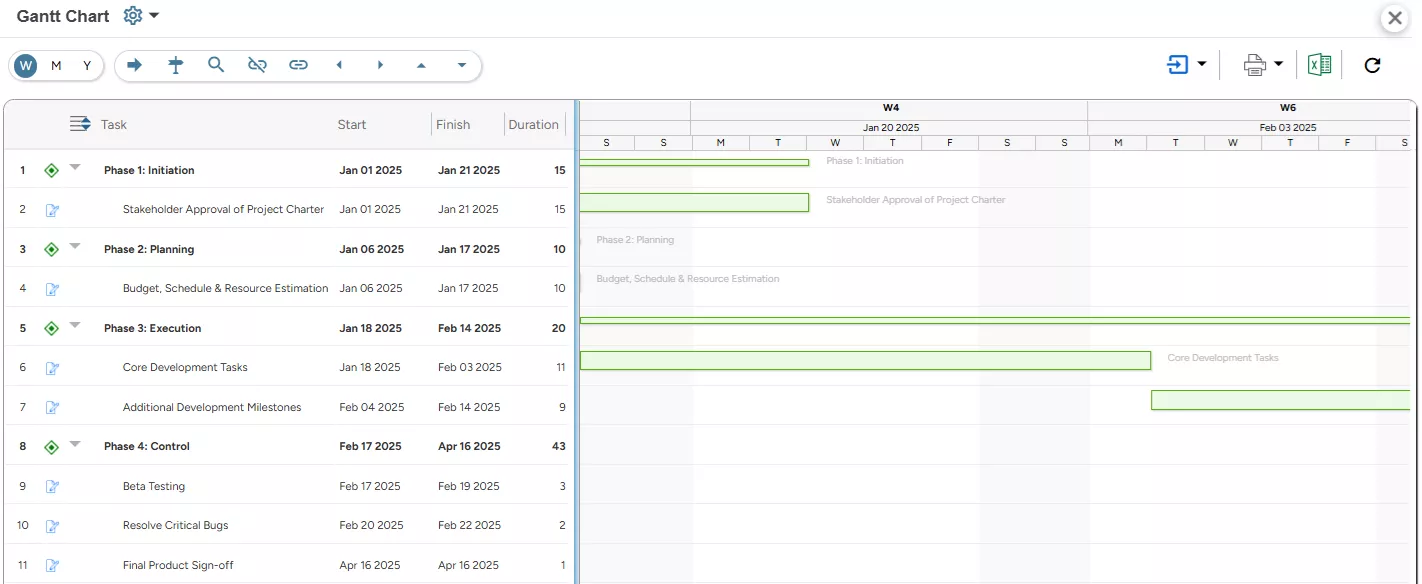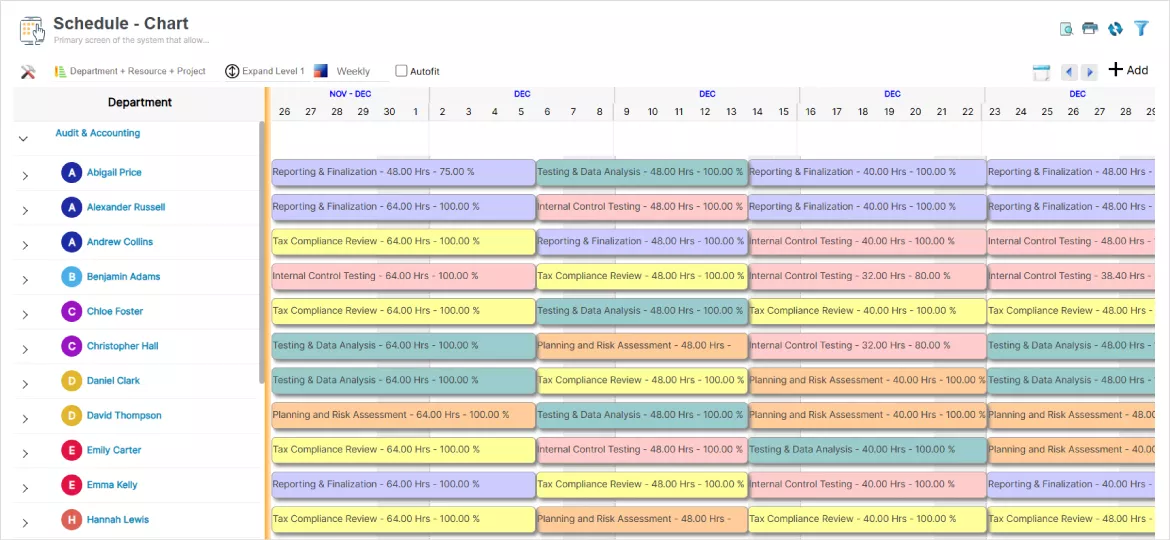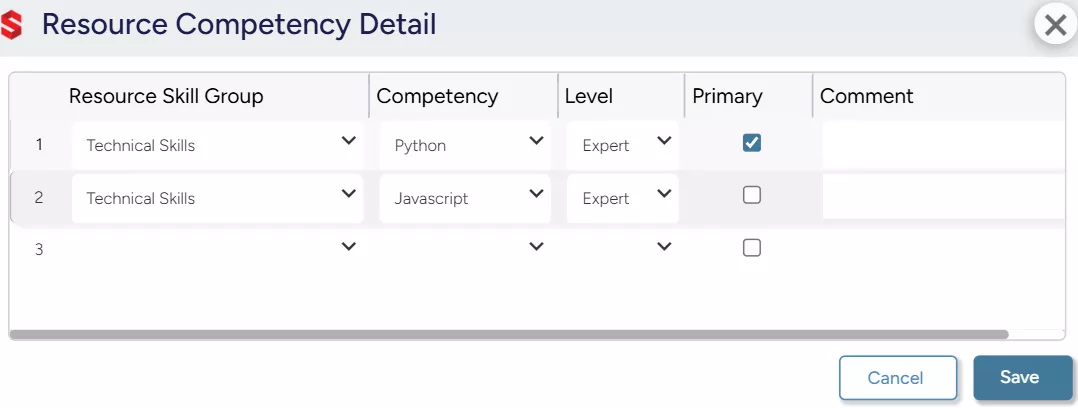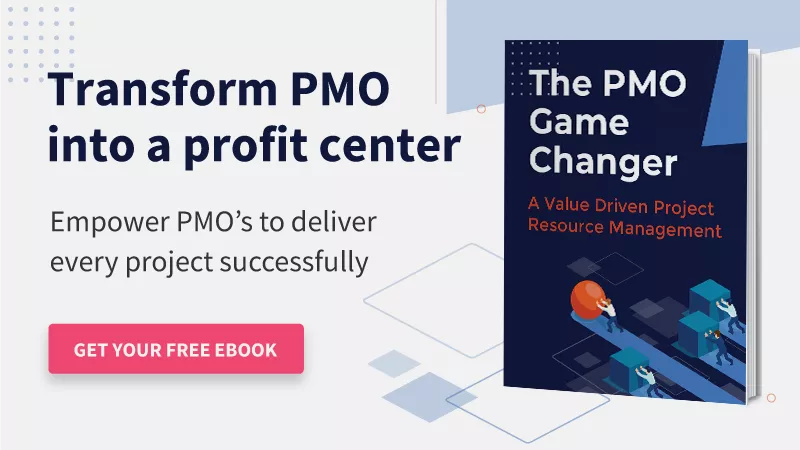“Great things are not done by impulse but by a series of small things brought together.”~ Vincent Van Gogh
This quote perfectly highlights the value of breaking down complex goals into manageable steps. In a similar way, project milestones are used to divide a project into smaller phases. They act as critical checkpoints that mark essential achievements or indicate the completion of major tasks, phases, or deliverables.
For project managers, milestones provide a structured framework for tracking progress and maintaining focus. On the other hand, milestones boost team morale by recognizing the smaller accomplishments throughout the project, fostering a sense of achievement. Hence, milestones are crucial as they help managers and the team to work effectively to drive projects to success.
This article provides invaluable insights into project milestones, including their importance, key challenges, and steps to create them.
Let’s dive in.
What is Project Milestone?
Project milestones are defined as the checkpoints in a project schedule that represent significant events. They are the key performance index (KPI) that depicts the project’s high-priority tasks, key deliverables, client or stakeholder approval, start or end date of project phases, important meetings, etc.
Let’s understand project milestones with an example.
Examples of Project Milestones
An IT company has a software development project in the pipeline. The goal is to release a beta version of the application within four months while adhering to a USD 350,000 budget. To achieve this, the project manager identifies key milestones based on the various project phases.
Milestone 1- Stakeholder Approval of the Project Charter (Initiation Phase)
The first milestone involves obtaining a sign-off on the project’s feasibility, scope, and objectives. This marks the official start of the project, ensuring clarity of purpose and buy-in from stakeholders.
Milestone 2- Budget, Schedule & Resource Estimation (Planning Phase)
The second milestone focuses on finalizing a comprehensive budget, project schedule, and resource allocation plan. This provides a clear roadmap for execution, ensuring the project remains within budget and on schedule.
Milestone 3- Completion of Core Development Tasks (Execution Phase)
The third milestone involves delivering all core features of the application, ensuring functionality meets the initial specifications. It’s important to note that there can be multiple milestones within the execution phase, depending on the complexity of the project.
For example, additional milestones might include the implementation of data encryption, building dashboards for analytics, integration with third-party APIs, etc.
Milestone 4- Beta Testing (Control Phase)
The fourth milestone involves completing user acceptance testing (UAT), resolving critical bugs, and obtaining final sign-off on the product. This marks the final step before the beta version is released to a wider audience, ensuring quality and reliability.
These milestones help track the software development project effectively, ensuring smooth progress across each phase.

SAVIOM’s Gantt Chart enables users to view project milestones and identify task dependencies.
Now that you’re aware of project management milestones examples, let’s explore the common myths related to them.
Breaking Down the Myths About Project Management Milestones
Often, project milestones are misconstrued with goals, tasks, deliverables, and phases within the project management realm. The following section will help clarify these misconceptions.
Milestone vs. Goal
Though project milestones and goals seem similar, in reality, they are entirely two very different things. Goals are what you and your team aim to achieve in the future, such as increasing sales by 50% by the end of the fourth quarter. On the contrary, project milestones evaluate progress and act more like stepping stones towards your objective.
Milestone vs. Task
Tasks are a set of actionable items from the overall project activity list that usually have an estimate of time. Meanwhile, milestones are simply significant events on the project schedule. For example, a web development project involves tasks like ‘creating mockups’ and ‘developing wireframes’. In contrast, a ‘design completion milestone’ signifies accomplishing all the design work and getting the approval to proceed with development.
Read More: How Resource Optimization Boosts Task Management?
Milestone vs. Deliverable
In project management, both deliverables and milestones serve distinct purposes despite their mutual goal of measuring project progress. A milestone is a specific point in time that shows progress towards the end objective. On the other hand, deliverables are quantifiable outcomes or the result of work completed, such as a report, design, or product/application.
Milestone vs. Phase
Phases are a broader segment of a project lifecycle, consisting of related tasks and activities. On the other hand, the project milestones act as a checkpoint to track progress but do not involve any actual work. Milestones are the mini-goals within each project phase. However, the number of phases and milestones in a project plan varies depending on the complexity.
Let’s now understand the significance of milestones in project management.
Read More: What is a Project Plan & How to Create an Effective One?
The Importance of Milestones in Project Management
Project milestones help team members and managers stay accountable and keep things on track for smooth project delivery. Let’s learn some benefits of it:
Assists in Setting Goals & Achieving Them
Project managers use milestones to divide the project phases into small, manageable objectives. Moreover, they use these markers as tangible mini-goals the team can focus on at each project stage. This dissection enables project teams to understand their current progress, assess the distance to the finish line, and work collectively to achieve the final outcome.
Aids in Tracking Budget and Timeline
A project’s success is defined by two elements: timely delivery and adhering to the stipulated budget. The finances and timeline are mostly planned at the start of the project. Milestones between project phases help managers check planned vs. actuals in terms of project budget and timeline and take necessary corrective actions ahead of time, preventing derailment.
Fosters Collaboration Among Team Members
Effective team collaboration is vital when a project involves multiple resources and perhaps even team members from diverse locations/time zones. Milestones provide clarity on the responsibility of individuals and teams, encouraging cross-departmental collaborations. This way, they coordinate efforts, which enhances teamwork, boosts productivity, and ensures projects are delivered on time and within budget.
Read More: 10 Ways to Improve Cross-Departmental Collaboration
Identifies Potential Bottlenecks Early
Bottlenecks within a project can severely impact the subsequent tasks, resulting in delays. Hence, by incorporating milestones, teams can monitor whether the project is on track and analyze gaps early. Accordingly, they can take timely corrective actions to resolve the issues and ensure the project progresses toward its final goal.
Supports Agile Project Approaches
In agile projects, milestones often coincide with the completion of a sprint. These checkpoints provide a way to measure progress and evaluate whether the project is meeting the client’s requirements and expectations. Milestones in agile projects offer flexibility while still maintaining structure, allowing teams to adjust priorities and make continuous improvements in response to feedback.
Read More: What is Agile Project Management & How to Effectively Manage Resources?
Facilitates Communication with Stakeholders
Stakeholders typically don’t need a detailed, in-depth report on every aspect of the project’s progress. Instead, they are looking for high-level updates that reflect whether the project is on track. Here, setting milestones enables managers to show the project progress to the stakeholders. These markers help stakeholders easily visualize how much work has been accomplished, how much is pending, and whether all the work aligns with the original project plan.
Ensures Deliverables Meet Quality Standards
Milestones make it easy for project teams to prioritize work and deliver results efficiently. At each milestone, key deliverables can be assessed to ensure they meet the predefined quality criteria. This process allows for early detection of quality issues, which can be addressed before they affect the later stages of the project. Therefore, it helps achieve high-quality outcomes that align with project goals and clients’ expectations.
Let’s move to the next section, which underlines the prevalent challenges that project managers experience during milestone delivery.
Common Challenges Faced During Milestone Delivery
Here’s a list of a few top challenges encountered by managers during project milestone delivery.
Shortage of Critical Resources
In a dynamic project environment, shortages can easily occur without clear visibility into the required resource skills or capacity. Accurate planning becomes difficult without an effective resource forecasting system, leading to gaps between demand and capacity. This misalignment results in last-minute firefighting and wrongful hiring, which compromises resource quality and delays milestone delivery.
Read More: What is Resource Forecasting? A Guide for Project Managers
Poor Milestone Planning
Milestone planning is one of the most critical components of project planning, as it serves as a visible indicator of progress. In contrast, poor project milestone planning can put resources under strain due to increased workload, causing overutilization. Consequently, it leads to missed deadlines, poor deliverable quality, and, ultimately, project delays.
Sudden Scope Changes
Scope creep is one of the most prominent project management challenges. If not addressed appropriately, it can cause budget overruns, delay milestone delivery, and compromise the project’s objectives. For instance, if a client requests changes to the original design of a website mid-project, it forces managers to reallocate resources, set a new timeline, and revise deliverables, impeding the overall “web-design” milestone.
Read More: What is Scope Creep, and How to Avoid it in Project Management?
Budget Issues & Miscommunication
Poor project budget planning and ineffective communication can create challenges when setting project milestones. If the project exceeds its budget or lacks adequate funding for certain phases, it may delay milestone completion. Moreover, miscommunication between project managers, financial teams, and stakeholders about budget expectations or allocations can exacerbate these issues, causing further delays, confusion, or errors.
Limited Stakeholders Engagement
A lack of stakeholder engagement occurs when the key members do not participate actively in guiding and shaping the project execution and providing feedback. Due to this inactive participation, project goals become unclear, priorities may shift without notice, and it becomes difficult to set milestones appropriately and complete the project on time.
Inappropriate Risk Management
Projects rarely go as planned, as they face unexpected risks that can disrupt the workflow. Such risks could be technical, resource-related risks, stakeholder resistance, budget or schedule issues, or market risks. If not addressed in a timely manner, these risks can negatively affect the project’s health, inflate the budget, reduce work quality, and cause significant delays in meeting critical milestones.
Read More: Enterprise Risk Management Framework: 8 Core Components
However, to overcome these challenges, it’s essential to have a clear strategy in place. Let’s learn about creating project milestones effectively.
How to Create Project Milestones?
Setting milestones in the early phases of the project lifecycle offers a broad view of what to expect with the project’s progress. The steps listed here will help you define the right milestones for your projects.
Develop a Project Plan
Creating a detailed project plan is the first in the process. It is the core component of every project, providing the team with a roadmap to achieve desired goals & objectives. Moreover, this plan is vital to ensure seamless execution of every phase and milestone and drive the project to success.
A project plan involves defining the project scope, establishing goals, assessing resource requirements, identifying risks, setting a budget and timeline, and outlining key deliverables. Once these high-level prerequisites are established, managers can begin breaking the project down into smaller, more manageable tasks and milestones.
Create Tasks and Subtasks
The next step involves creating a WBS (work breakdown structure). This hierarchical decomposition divides the project into smaller, workable components- tasks and sub-tasks. These individual tasks and sub-tasks represent the work needed to achieve broader objectives.
A structured task list allows project teams to identify and focus on high-priority project activities. Moreover, it helps in assigning responsibilities to appropriate resources, estimating timelines, and ensuring that no critical aspects of the project are overlooked.
Read More: Effective Ways to Create a Work Breakdown Structure
Identify the Key Deliverables
Once the WBS is created, project managers can identify key deliverables within each phase. These deliverables represent important project outcomes or significant achievements, and managers must select the most critical ones as milestones for the project.
For instance, in a construction project, finishing the foundation work and completing the structural framework of a building are key deliverables that indicate significant progress. Therefore, these outcomes can be considered an execution phase milestone.
Define Each Milestone In-Depth
Each milestone should be defined in detail, specifying what constitutes successful completion. This includes outlining the deliverables, tasks, and performance expectations for every milestone. The more specific the milestones are, the easier it will be to track progress and ensure that no steps are skipped.
Furthermore, these tasks should have a thorough description of what they entail. Such in-depth clarification of each task and subtask enables team members to understand their roles and responsibilities. Ultimately, it leads to better focus and increases the likelihood of completing milestones on time.
Seek Feedback from Stakeholders
Before finalizing the milestones, it’s important to seek feedback from key stakeholders, such as clients, team members, senior executives, and external partners who have an interest in the project’s outcome. Their valuable input and approval are crucial to ensuring the milestones are realistic, achievable, and aligned with the broader project goals.
Moreover, it ensures that changes or requests are addressed promptly, saving project teams from constant back-and-forth. Additionally, proactive stakeholder engagement helps identify gaps or issues early in the process, allowing for necessary adjustments before the project moves forward.
Read More: Who are Project Stakeholders, and How to Manage Them Efficiently?
Communicate Milestones with the Team
The next step is to communicate the finalized milestone with the rest of the project team. It’s crucial to clearly convey the importance of each milestone, what it entails, and how it fits into the broader project goals. When everyone knows the critical milestones of the project, they work collaboratively and effectively toward achieving them.
Furthermore, transparent communication ensures that everyone understands their respective roles and the timing of the milestones. It also promotes accountability, as team members can track their own progress and contribute to meeting project milestones, reducing the risk of misunderstandings or delays.
Visualize Milestones Using Gantt Charts
In a project-centric organization, managers need to manage multi-faceted projects simultaneously. This is where a Gantt Chart is helpful, providing real-time visibility of both project and resource schedules on a single, centralized platform. Moreover, it allows the stakeholders to view the milestones easily and gauge the project’s performance.
Similarly, it helps managers track the project’s functional characteristics like the milestone schedules, allotted time for each milestone delivery, assigned resources, etc. This visual representation helps identify dependencies, monitor progress, and ensure timely completion of project milestones.
Read More: What is a Gantt Chart: Benefits, Examples, & Best Practices
Use a Project Milestone Template
Lastly, you can utilize a project milestone template, as it provides a standard format for tracking progress. This makes it easier for team members to see where they are in the project and what remains to be done. It’s preferable to use a template in the Gantt format as it makes it easy for project managers to communicate project timelines and milestones easily to stakeholders.
Moreover, this template can highlight the project’s critical path, help assign work to team members, and identify dependencies. Ultimately, these templates help maintain focus on key deliverables and provide a simple, repeatable process for achieving milestones.
Now that the steps to set project milestones are clear, here’s a section on how resource management software can ensure effective milestone delivery.
Role of Resource Management in Project Milestone Delivery
For effective project management, a robust resource management framework plays a crucial role. Let’s understand in detail how it contributes significantly to the successful project milestone fulfillment;
Ensures Optimal Resource Allocation
A project encompasses multiple milestones, and each milestone may have specific resource requirements. With a robust resource management tool, managers can gain unmatched visibility of all resources and their skill sets. Based on this information, they can allocate the right people to the right tasks and activities, ensuring higher productivity and better quality of deliverables.
Read More: What is Resource Allocation, and Why is it Important?

SAVIOM’s Multi-dimensional Resource Scheduler provides 360-degree visibility of project resource schedules.
Manages Sudden Ramp-Down of Resources
A resource management tool provides managers with 360-degree visibility into the project and resource schedules. These insights help managers identify when the ramp-down of resources is happening, allowing them to plan and reassign members to other tasks proactively. This way, they can maximize resource utilization, reduce bench time, and maintain project workflows.
Balances Workload to Avoid Under/Overutilization
Resource management software provides color-coded heatmaps and utilization reports to assess project team utilization. This helps them recognize and rectify under and overloading. For instance, if resources are underutilized, managers can allocate more work to them. Contrarily, if overutilized, techniques like resource leveling & smoothing can be used. This helps balance the workload and ensure optimal utilization.
Read More: What is Resource Utilization? A Complete Guide to Improve Business Efficiency
Controls Resource-Related Expenses
The tool provides visibility into future project demand. This foresight provides sufficient lead time to identify and deploy cost-effective global resources to control the project budget. Moreover, the tool facilitates skill matching, which prevents the allocation of over-qualified professionals to project tasks, ultimately cutting down resource-related expenses.

SAVIOM’s real-time Skill Matrix offers unmatched visibility into each resource’s skillsets, qualifications, and competencies.
Identifies Potential Resource Constraints
Resource constraints can bring the project to an abrupt halt. However, the software’s real-time business intelligence dashboards can help managers track key metrics such as resource utilization, availability, capacity, etc., and take corrective action to address variances. Moreover, the what-if analysis feature enables them to achieve the best possible utilization within existing workforce constraints.
Read More: What are Resource Constraints, and How Does It Affect Project Success?
Conclusion
It is now evident that project management has evolved into a complex domain, and therefore, fractionating it with milestone delivery is essential. With a proper project resource management framework, managers can efficiently track critical events and utilize resources to the maximum. This tool provides a collaborative platform with real-time data that ensures your team works productively and delivers project milestones successfully.
How do you accomplish successful milestone delivery in your projects?
The Glossary
Read More: Glossary of Resource Workforce Planning, Scheduling and Management












